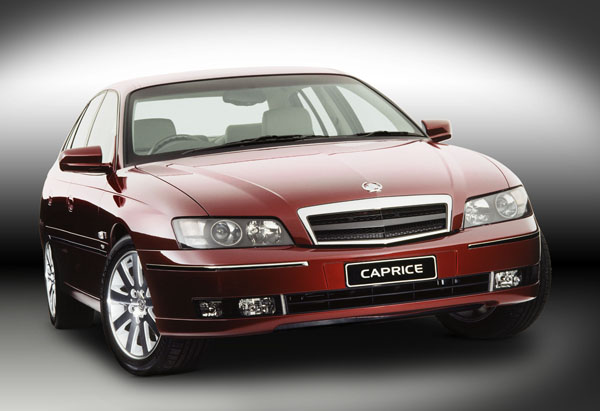With Holden about to pull out of local manufacturing and start importing the next generation Commodore from Germany other car companies are rushing to try and fill the gap. But none of them can offer a large spacious sedan like the Holden Statesman or Caprice.
These long wheelbase versions of the standard Commodore sedan offer stretch out comfort in the rear seats.
Though not as refined as the large, upmarket European sedans these big Holdens are better suited to local road conditions than the Germans, Brits and Japanese.
Will the loss of the stretched Holdens from the new car market result in increases in prices of used models, particularly ones on immaculate condition? We tend to think the answer is Yes. No promises, though…
As the big Holdens are aimed at luxury car buyers their rear seats are shaped for two adults with a bit of left over space between them for a smaller third seat. If you want to use them as a family car you may find the one in the centre seat misses out on some comfort.
Boot size is good, though not outstanding, being about the same as in the standard Commodore. That’s because the stretch has gone into more passenger space not more luggage room.
These are large cars that need large parking spots. Otherwise, the Statesman and Caprice are as simple to drive as any other Commodore in day-to-day use.
Until the WM series from August 2006 the big Holdens were built on the same long-wheelbase platform as the Commodore station wagon. From WM onwards they have shared their wheelbase, but added body length.
A strong feature of the WM and the WN that succeeded it in May 2013 is the greater differentiation in style between it and the Commodore, with only the front doors being shared.
Power in the WK Series, came from either a 3.8-litre V6 or a 5.7-litre V8. Some of the V6s in the Statesman were supercharged, these were not popular and were soon withdrawn from production.
The engine size of the V6 was reduced to 3.6 litres with the introduction of the WL Series in August 2004. The engine was an all-new modern design and provides a lot more power than the 3.8-litre. The standard V6 was taken off the market with the introduction of the WN Series. However, the LPG version of the V6 was retained for lower spec versions aimed at the taxi market.
A 6.0-litre V8 was installed in the WM from 2006 and is an excellent unit. It’s not as thirsty as you might expect, though certainly can’t be called an economy car.
All these luxury Holdens are powered through automatic transmissions. These work well, giving all but imperceptible changes and a feeling of quality and refinement.
Though not as easy to work on as the simpler Commodore, the Statesman and Caprice have plenty of room under the bonnet and good home mechanics can do a fair bit of routine work.
Spare parts are readily available Australia-wide and prices are very reasonable for a car of this size and luxury.
Insurance costs are low and most companies make no differentiation in premiums for the V8 and supercharged versions. However, if you’re young or inexperienced you may have to pay more for the V8s. Shop around.
Statesman and Caprice have been popular with limousine operators and government fleets for many years. For obvious reasons they preferred to buy the topline line model, the Caprice, so Holden ceased production of the Statesman in 2010. We have seen quite a few Statesmans that are still in excellent condition so don’t write them off. But be sure to have a full professional inspection.
WHAT TO LOOK FOR
Don’t even contemplate buying one of these upmarket Holdens without a full professional inspection. They are significantly more complex than standard Commodores and later models were crammed with technology for their time.
Get a written quote on all repairs needed because some apparently minor problems on these upmarket Holdens can be expensive.
Check the interior for signs of wear and tear, particularly in the rear seat area.
Similarly with the boot, hard usage there may mean the big Holden has been a taxi in an a previous life.
Older engines may be relatively harsh under full acceleration. If it seems too bad get a professional opinion.
Automatic transmissions that have slurred changes or are slow to go into gear from Neutral or Park may be due for an overhaul.
Listen for a whining noise at the differential when accelerating or decelerating at speeds of around 60 to 90 km/h. It’s not usually there at steady running speeds.
Check that the brakes pull the big Holden up squarely, any pulling to one side that’s not caused by camber on the road should be treated with suspicion.
HOW MUCH?
Expect to pay from $3000 to $5500 for a 2003 Holden Statesman V6; $5000 to $8500 for a 2005 Statesman V8; $9000 to $14,000 for a 2008 Caprice V8; $11,000 to $17,000 for a 2010 Statesman V8; $16,000 to $22,000 for a 2011 Caprice V; $22,000 to $30,000 for a 2013 Caprice V; $26,000 to $34,000 for a 2014 Caprice V LPG; $29,000 to $40,000 for a 2015 Caprice V; and $33,000 to $45,000 for a 2016 Caprice V.
CAR BUYING TIP
Having someone else with you when you are looking at used cars is handy for getting second opinions, even for spotting faults you missed…
